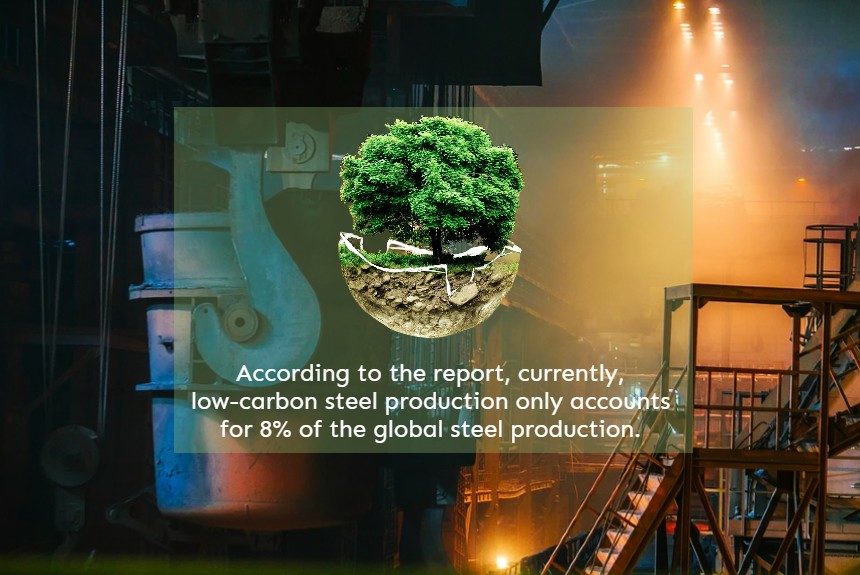Steel production is one of the largest emitting industries, accounting for 6% to 7% of global GHGs. To adhere to the 1.5°C pathway, the industry must develop a low-carbon process or decarbonize steelmaking altogether.
With investments pouring in, new technologies are emerging to create low-carbon and sustainable steelmaking processes to produce green steel.
According to GreenBiz, Bill Gates’s startup company, Boston Metal, designed to make carbon-zero steel, raised $50 million in funding in January 2021. Sweden’s new commercial hydrogen steel plant raised almost $4 billion, and Swedish miner LKAB invested $46 billion to reach net-zero emissions by 2045.
The article highlights three companies that are developing new technologies to create green steel.
First is the Japanese company Kobe Steel, which makes steel using natural gas furnaces and less coke.
The company reduced its CO2 emissions by 20% by adding hot briquetted iron at a precise ratio to its blast furnaces. However, the company realized that it needed to increase the reduction from 20%, so it looked at investing in hydrogen alongside its carbon-efficient furnaces.
Second, the Netherlands-based EIT InnoEnergy, a hydrogen-based steel plant funded by the EU, partners with Scania, a Swedish truck maker, and develops a commercially scaled green steel operation called H2 Green Steel.
The partnership aims to produce 5 million metric tons of green steel by 2024. According to the partners, this capacity will make the plant the largest globally.
However, according to Thomas Koch Blank of RMI, to make green steel production truly net-zero, it has to use renewable energy to produce hydrogen. To meet this goal, we will need three times more solar and wind energy sources than we have now to power the green steel industry.
The third company is Boston Metal, which uses molten oxide electrolysis technology created by MIT.
According to the article, molten oxide electrolysis separates oxygen from iron ore using electricity and creates O2 as the byproduct instead of CO2. Boston Metal is tasked with bringing this technology to a commercial level in the next two to three years, bringing its laboratory success into the market.
This technology will use electrolysis but won’t take it to the next step to produce hydrogen, simplifying the process. However, electrolysis will require a massive amount of clean power to make it truly carbon-free, so the technology will work well in regions like Canada, Australia, and Europe, where renewable energy sources are abundant.
According to the article, a billion tons of virgin steel are produced each year, and each company and technology wants a piece of the market. There will be room for all of them because it will take many innovations and pathways to decarbonize this carbon-heavy industry.
Another report from the Rocky Mountain Institute, The Disruptive Potential of Green Steel, says that decarbonizing the steel industry is a climate imperative. The report discussed non-coal-based technologies being piloted for steelmaking in the EU, United States, Sweden, and China, such as carbon capture and storage (CCS), molten oxide electrolysis (MOE), and hydrogen direct reduction (HDR).
It also shows the carbon reductions achieved by the above countries using low-carbon technologies. When comparing the costs of producing green steel through HDR and MOE, it is competitive with the prevailing blast furnace reduction without a carbon tax and an electricity price of $15 to $30/MWh.
According to the report, low-carbon steel production currently accounts for only 8% of global steel production.
However, there are opportunities to accelerate the steel transition through a combination of interventions and pathways and mitigate climate change impacts.
To view the entire brief, click the link below:
Sources:
Klein J. (2021, April 14). 3 innovations in green steel. GreenBiz. Retrieved from https://www.greenbiz.com/article/3-innovations-green-steel
Blank, T. (2019). The Disruptive Potential of Green Steel. Rocky Mountain Institute. Retrieved from https://rmi.org/wp-content/uploads/2019/09/green-steel-insight-brief.pdf



Leave a Reply